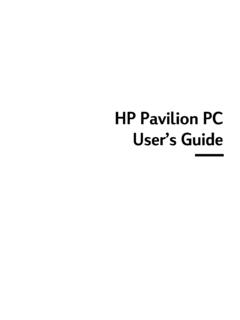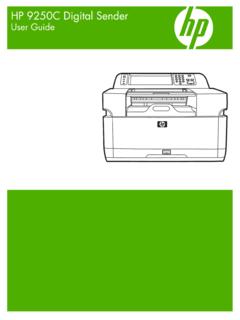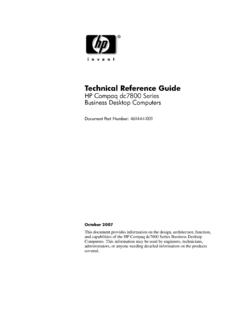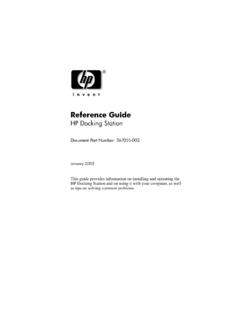Transcription of Data Execution Prevention - h10032.www1.hp.com
1 1 data Execution .. 2 data Execution Prevention (DEP) .. 3 What does data Execution Prevention do? .. 3 data Execution Prevention Exception Message Box .. 3 Hardware-Enforced DEP .. 3 What is PAE? .. 4 Why is this change important? What threats does it help mitigate? .. 4 Will my NX- or XD-enabled systems protect me from virus attacks? .. 5 What are the required components for XD/NX to function? .. 5 How do I control the DEP functionality on my computer? .. 8 DEP Level Chart .. 9 data Execution Prevention Tab - No XD/NX Processor .. 10 Software-Enforced DEP .. 10 Deploying Hardware-Enabled data Execution Prevention .. 11 How will XD/NX impact HP customers? .. 11 What about customers who create their own software image? .. 11 Advantages of using XD/NX .. 12 Disadvantages of using XD/NX .. 12 Conclusion and Recommendation.
2 12 Known Issues ..13 Frequently Asked Questions .. 162 Based upon Microsoft TechNet article Changes to Functionality in Microsoft's Windows XP Service Pack 2, dated August 9, 2004, by Starr Anderson & Vincent Microsoft s Windows XP Service Pack 2 introduces a set of security technologies that will help improve the ability of computers running Windows XP to withstand malicious attacks, especially those from viruses and worms such as Code Red, Blaster and Corporation s data Security Summary for 2004 reports that there are now in excess of 100,000 recognized viruses, with Sasser being the most recent major epidemic. Released in May 2004, this auto-matic network worm quickly spread, and reportedly affected three major banks, an Australian Railroad, county hospitals in Sweden, and the European Commission in Brussels, to name a s Windows XP Service Pack 2 includes multiple security improvements: Network protection Memory protection Email handling Web browsing security Computer maintenanceTogether, these security technologies help to make it more difficult to attack Windows XP, even if the latest antivirus updates are not paper focuses on the aspect of memory protection and how data Execution Prevention helps lock down the ability for malicious code to propagate through the network.
3 However, you should expect some application behaviors to be incompatible with data Execution Prevention . Applications that perform dynamic code generation (such as Just-In-Time code generation) that do not explicitly mark generated code with Execute permission may have compatibility issues with data Execution recommends that customers test Windows XP Service Pack 2 before wide scale deployment in their Execution Prevention (DEP)What does data Execution Prevention do? data Execution Prevention (DEP) is a set of hardware and software technologies that perform checks on memory to help protect against malicious code and viruses. In Windows XP SP2, DEP is enforced by both hardware and Execution Prevention Exception Message BoxIf an application or driver attempts to execute code from an area where it should not on a DEP-protected computer, Windows displays the following exception error:Hardware-Enforced DEPH ardware-enforced DEP marks all memory locations as non-executable (you cannot execute code in this portion of memory) unless the location explicitly contains executable code.
4 There is a class of attacks that attempts to insert and execute code from non-executable memory locations. DEP helps prevent these attacks by intercepting them and displaying the DEP message DEP relies on processor hardware to mark memory with an attribute that indicates that code should not be executed from that memory. The actual hardware implementation of DEP varies by processor architecture. However, processors that support hardware-enforced DEP are capable of rais-ing an exception when code is executed from a memory location where it should not be Advanced Micro Devices (AMD) and Intel Corporation have defined and shipped Windows-compatible architectures that support DEP. Beginning with Windows XP Service Pack 2, the 32-bit version of Windows utilizes the no-execute page-protection (NX) processor feature as defined by AMD and the Execute Disable (XD) bit feature as defined by Intel.
5 AMD also refers to this feature as Enhanced Virus Protection. To use these processor features, the processor must run in Physical Address Extension (PAE) mode. HP ships Windows XP with PAE is PAE?The XD and NX features require that the processor run in Physical Address Extension (PAE) mode. A 32-bit processor, such as the Intel Pentium 4 (IA32 family), is usually limited to addressing a maximum of 4-GB of memory. This limitation is due to 32 bits of address capability, as follows:232 = 4,294,967,296 (4 GB)To address more than 4-GB of memory, Intel created PAE mode. PAE uses an additional 4 bits of address-ing, creating a 36-bit address, thereby allowing for the addressing of up to 64-GB of memory, as follows:236 = 68,719,476,736 (64 GB)A processor with XD or NX marks memory pages as nonexecutable. This marking consists of a bit in the Page Table Entry (PTE), which is a data structure containing the base physical address and attributes of a page in physical memory.
6 When you use PAE mode, the PTEs are extended from 32 bits to 64 bits, allow-ing for the additional space required to mark an area as is this change important? What threats does it help mitigate?The primary benefit of data Execution Prevention is the Prevention of code Execution from data pages such as the default heap, various stacks, and memory pools. A heap is a common pool of memory avail-able to a program. A stack is a set of hardware registers or a reserved amount of memory used for arith-metic calculations or to keep track of internal normal system operations, code is not typically executed from the default heap and stack. Hardware-enforced DEP detects code that is running from these locations and raises an exception when Execution occurs. If the exception is unhandled, the process is terminated. Execution of code from protected memory in kernel mode results in a terminating a process or causing the system to fail with a bugcheck do not appear to be ideal solutions, they help prevent malicious code from executing.
7 Preventing malicious code from executing on the system may prevent damage to your system or propagation of malicious code whose harmful effects could easily exceed those of a process terminated by a can help mitigate against a class of security exploits. Specifically, data Execution Prevention can pre-vent the exploit in which a virus or other attack injects a process with additional code and then attempts to execute the injected code. On a system with DEP, Execution of the injected code results in an exception. Additionally, software-enforced DEP can help mitigate against exploits of exception handling mechanisms within secondary benefit of DEP encourages good engineering and best practices for application and driver developers. data Execution Prevention forces developers to avoid executing code out of data pages with-out explicitly marking the pages as my NX- or XD-enabled systems protect me from virus attacks?
8 XD and NX are promising technologies, but they do not protect against all attacks. You should use XD and NX with antivirus software, firewall, and other security measures to reduce the propagation of viruses and limit the amount of damage they can are the required components for XD/NX to function?To take advantage of the XD/NX feature, the following components must support XD/NX: Processor System BIOS Operating systemProcessorIntel released XD-capable processors for the desktop market starting with the E0 stepping of the Prescott Pentium 4 processor. Both Intel Pentium 4 and Celeron processors have XD support. Using Intel s new pro-cessor naming scheme, all 6xx, 7xx, and 8xx processors support XD. A majority of 5xx and 3xx proces-sors also support has released a line of AMD64 processors (Athlon 64, Athlon 64 FX, Turion 64 Mobile Technology, Mobile Athlon 64) which support NX.
9 Transmeta Efficeon processors using Code Morphing Software (CMS) or later support NX. Both Intel and AMD have a Windows-compatible method of implementing XD/NX, but their hardware imple-mentation is different. Transmeta Efficeon processors use a virtual implementation compatible with the AMD do I know if I have an XD- or NX- capable processor?The System Properties window indicates whether PAE is enabled on systems installed with Windows XP SP2 that also have an XD- or NX-capable BIOS Default XD support is disabled for Intel 915 2004 systems. Default XD support is enabled for Intel 945 2005 systems. Default NX support is enabled for AMD 2005 systems. Default NX support is disabled for Transmeta BIOS for Intel 915 and Intel 945 based desktop systems uses the CPUID instruction to look for the Exe-cute Disable bit to determine if XD is supported with the installed processor.
10 If the processor supports XD, then the data Execution Prevention option appears in the Security section of F10 Setup. The user can enable or disable this processors currently do not have an option to manually disable DEP in F10 Setup. Transmeta pro-cessors currently do not have an option to manually enable DEP in F10 data Execution Prevention option is disabled by default in i915-based systems, and enabled by default in i945-based systems. Applications and drivers run without compatibility problems when the XD feature is not uses the i915 chipset desktop BIOS family in the following product lines (not all systems available in all regions): dc5100 dx6100 dc7100HP uses the i945 chipset desktop BIOS family in the following product lines (not all systems available in all regions): dc7600 dx7200HP uses the ATI Radeon Xpress 200 chipset desktop BIOS family for AMD processors in the following product line (not all systems available in all regions): dx5150 The BIOS for the bc1000 disables NX support for the Transmeta processor.













